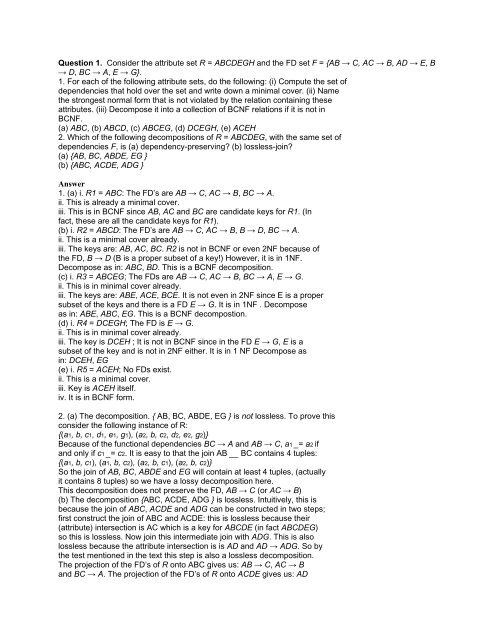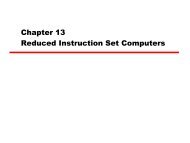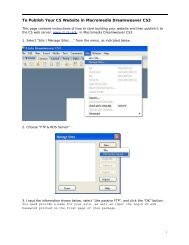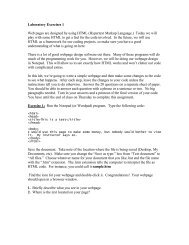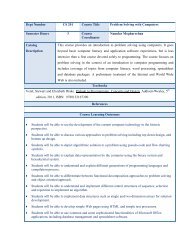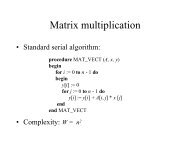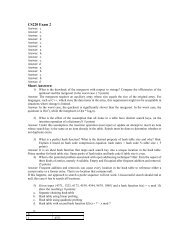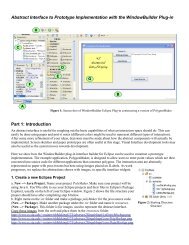Question 1. Consider the attribute set R = ABCDEGH and the FD set F
Question 1. Consider the attribute set R = ABCDEGH and the FD set F
Question 1. Consider the attribute set R = ABCDEGH and the FD set F
Create successful ePaper yourself
Turn your PDF publications into a flip-book with our unique Google optimized e-Paper software.
<strong>Question</strong> <strong>1.</strong> <strong>Consider</strong> <strong>the</strong> <strong>attribute</strong> <strong>set</strong> R = <strong>ABCDEGH</strong> <strong>and</strong> <strong>the</strong> <strong>FD</strong> <strong>set</strong> F = {AB → C, AC → B, AD → E, B→ D, BC → A, E → G}.<strong>1.</strong> For each of <strong>the</strong> following <strong>attribute</strong> <strong>set</strong>s, do <strong>the</strong> following: (i) Compute <strong>the</strong> <strong>set</strong> ofdependencies that hold over <strong>the</strong> <strong>set</strong> <strong>and</strong> write down a minimal cover. (ii) Name<strong>the</strong> strongest normal form that is not violated by <strong>the</strong> relation containing <strong>the</strong>se<strong>attribute</strong>s. (iii) Decompose it into a collection of BCNF relations if it is not inBCNF.(a) ABC, (b) ABCD, (c) ABCEG, (d) DCEGH, (e) ACEH2. Which of <strong>the</strong> following decompositions of R = ABCDEG, with <strong>the</strong> same <strong>set</strong> ofdependencies F, is (a) dependency-preserving? (b) lossless-join?(a) {AB, BC, ABDE, EG }(b) {ABC, ACDE, ADG }Answer<strong>1.</strong> (a) i. R1 = ABC: The <strong>FD</strong>’s are AB → C, AC → B, BC → A.ii. This is already a minimal cover.iii. This is in BCNF since AB, AC <strong>and</strong> BC are c<strong>and</strong>idate keys for R<strong>1.</strong> (Infact, <strong>the</strong>se are all <strong>the</strong> c<strong>and</strong>idate keys for R1).(b) i. R2 = ABCD: The <strong>FD</strong>’s are AB → C, AC → B, B → D, BC → A.ii. This is a minimal cover already.iii. The keys are: AB, AC, BC. R2 is not in BCNF or even 2NF because of<strong>the</strong> <strong>FD</strong>, B → D (B is a proper sub<strong>set</strong> of a key!) However, it is in 1NF.Decompose as in: ABC, BD. This is a BCNF decomposition.(c) i. R3 = ABCEG; The <strong>FD</strong>s are AB → C, AC → B, BC → A, E → G.ii. This is in minimal cover already.iii. The keys are: ABE, ACE, BCE. It is not even in 2NF since E is a propersub<strong>set</strong> of <strong>the</strong> keys <strong>and</strong> <strong>the</strong>re is a <strong>FD</strong> E → G. It is in 1NF . Decomposeas in: ABE, ABC, EG. This is a BCNF decompostion.(d) i. R4 = DCEGH; The <strong>FD</strong> is E → G.ii. This is in minimal cover already.iii. The key is DCEH ; It is not in BCNF since in <strong>the</strong> <strong>FD</strong> E → G, E is asub<strong>set</strong> of <strong>the</strong> key <strong>and</strong> is not in 2NF ei<strong>the</strong>r. It is in 1 NF Decompose asin: DCEH, EG(e) i. R5 = ACEH; No <strong>FD</strong>s exist.ii. This is a minimal cover.iii. Key is ACEH itself.iv. It is in BCNF form.2. (a) The decomposition. { AB, BC, ABDE, EG } is not lossless. To prove thisconsider <strong>the</strong> following instance of R:{(a1, b, c1, d1, e1, g1), (a2, b, c2, d2, e2, g2)}Because of <strong>the</strong> functional dependencies BC → A <strong>and</strong> AB → C, a1 _= a2 if<strong>and</strong> only if c1 _= c2. It is easy to that <strong>the</strong> join AB __ BC contains 4 tuples:{(a1, b, c1), (a1, b, c2), (a2, b, c1), (a2, b, c2)}So <strong>the</strong> join of AB, BC, ABDE <strong>and</strong> EG will contain at least 4 tuples, (actuallyit contains 8 tuples) so we have a lossy decomposition here.This decomposition does not preserve <strong>the</strong> <strong>FD</strong>, AB → C (or AC → B)(b) The decomposition {ABC, ACDE, ADG } is lossless. Intuitively, this isbecause <strong>the</strong> join of ABC, ACDE <strong>and</strong> ADG can be constructed in two steps;first construct <strong>the</strong> join of ABC <strong>and</strong> ACDE: this is lossless because <strong>the</strong>ir(<strong>attribute</strong>) intersection is AC which is a key for ABCDE (in fact ABCDEG)so this is lossless. Now join this intermediate join with ADG. This is alsolossless because <strong>the</strong> <strong>attribute</strong> intersection is is AD <strong>and</strong> AD → ADG. So by<strong>the</strong> test mentioned in <strong>the</strong> text this step is also a lossless decomposition.The projection of <strong>the</strong> <strong>FD</strong>’s of R onto ABC gives us: AB → C, AC → B<strong>and</strong> BC → A. The projection of <strong>the</strong> <strong>FD</strong>’s of R onto ACDE gives us: AD
→ E <strong>and</strong> The projection of <strong>the</strong> <strong>FD</strong>’s of R onto ADG gives us: AD → G(by transitivity) The closure of this <strong>set</strong> of dependencies does not contain E→ G nor does it contain B → D. So this decomposition is not dependencypreserving.<strong>Question</strong> 2. Suppose you are given a relation R(A,B,C,D). For each of <strong>the</strong> following<strong>set</strong>s of <strong>FD</strong>s, assuming <strong>the</strong>y are <strong>the</strong> only dependencies that hold for R, do <strong>the</strong>following: (a) Identify <strong>the</strong> c<strong>and</strong>idate key(s) for R. (b) State whe<strong>the</strong>r or not <strong>the</strong> proposeddecomposition of R into smaller relations is a good decomposition <strong>and</strong> brieflyexplain why or why not.<strong>1.</strong> B → C, D → A; decompose into BC <strong>and</strong> AD.2. AB → C, C → A, C → D; decompose into ACD <strong>and</strong> BC.3. A → BC, C → AD; decompose into ABC <strong>and</strong> AD.4. A → B, B → C, C → D; decompose into AB <strong>and</strong> ACD.5. A → B, B → C, C → D; decompose into AB, AD <strong>and</strong> CD.Answer<strong>1.</strong> C<strong>and</strong>idate key(s): BD. The decomposition into BC <strong>and</strong> AD is unsatisfactorybecause it is lossy (<strong>the</strong> join of BC <strong>and</strong> AD is <strong>the</strong> cartesian product which couldbe much bigger than ABCD)2. C<strong>and</strong>idate key(s): AB, BC. The decomposition into ACD <strong>and</strong> BC is lossless sinceACD ∩ BC (which is C) → ACD. The projection of <strong>the</strong> <strong>FD</strong>’s on ACD include C→ D, C → A (so C is a key for ACD) <strong>and</strong> <strong>the</strong> projection of <strong>FD</strong> on BC producesno nontrivial dependencies. In particular this is a BCNF decomposition (checkthat R is not!). However, it is not dependency preserving since <strong>the</strong> dependencyAB → C is not preserved. So to enforce preservation of this dependency (if wedo not want to use a join) we need to add ABC which introduces redundancy. Soimplicitly <strong>the</strong>re is some redundancy across relations (although none inside ACD<strong>and</strong> BC).3. C<strong>and</strong>idate key(s): A, C. Since A <strong>and</strong> C are both c<strong>and</strong>idate keys for R, it is alreadyin BCNF. So from a normalization st<strong>and</strong>point it makes no sense to decompose R.Fur<strong>the</strong>r more, <strong>the</strong> decompose is not dependency-preserving since C → AD can nolonger be enforced.4. C<strong>and</strong>idate key(s): A. The projection of <strong>the</strong> dependencies on AB are: A → B <strong>and</strong>those on ACD are: A → C <strong>and</strong> C → D (rest follow from <strong>the</strong>se). The scheme ACDis not even in 3NF, since C is not a superkey, <strong>and</strong> D is not part of a key. This isa lossless-join decomposition (since A is a key), but not dependency preserving,since B → C is not preserved.5. C<strong>and</strong>idate key(s): A (just as before) This is a lossless BCNF decomposition (easyto check!) This is, however, not dependency preserving (B consider → C). Soit is not free of (implied) redundancy. This is not <strong>the</strong> best decomposition ( <strong>the</strong>decomposition AB, BC, CD is better.)<strong>Question</strong> 3. <strong>Consider</strong> a relation R with five <strong>attribute</strong>s ABCDE. You are given <strong>the</strong>following dependencies: A → B, BC → E, <strong>and</strong> ED → A.<strong>1.</strong> List all keys for R.2. Is R in 3NF?3. Is R in BCNF?<strong>1.</strong> CDE, ACD, BCD2. R is in 3NF because B, E <strong>and</strong> A are all parts of keys.3. R is not in BCNF because none of A, BC <strong>and</strong> ED contain a key.


